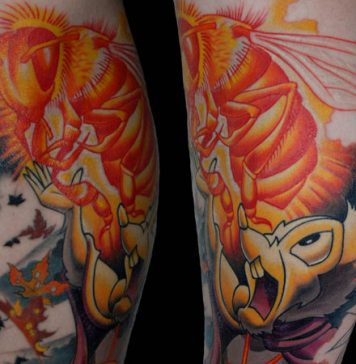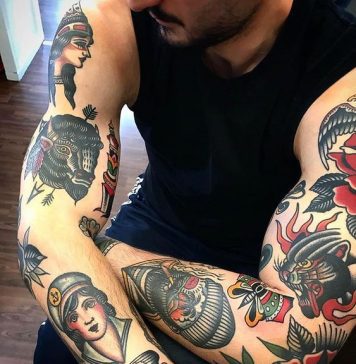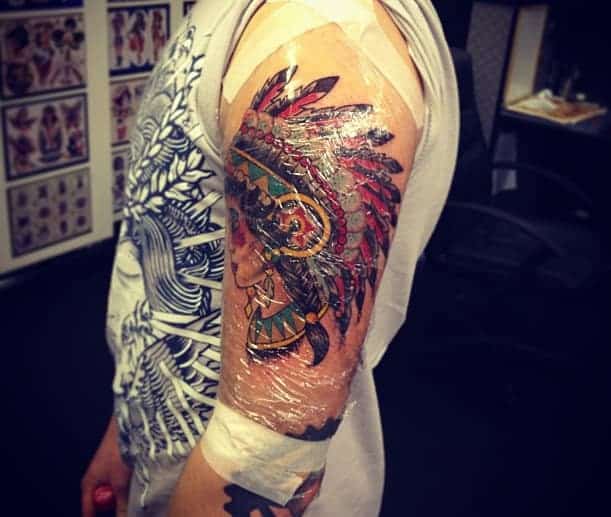
Getting a tattoo is all nice and good. They look cool, seductive, and fun. They also make a perfect expression of a person’s style. But before we even begin looking for the best artist, we need to first understand more about tattoo healing. Tending to a tattoo is not rocket science. Tattoo aftercare has to be done to ensure that the tattoo heals properly and you get to enjoy it for life!
Every tattoo undergoes a particular healing process. The healing process is typically broken down into three various stages – and each of these stages are further divided into substages (these substages refer to day-to-day healing). You may notice that a tattoo can heal after several days (or after several months). Regardless of the duration, it is necessary to execute consistency when it comes to aftercare.
Tattoo Healing Process and Stages
The process of tattoo healing occurs in several stages. Although the phases of tattoo aftercare may differ from person to person knowing what to expect certainly helps. Starting from the basic restoration, the proper tending, and the extent of tattoo healing, you should equip yourself with the proper knowledge on the healing process. The last thing you would want is to become paranoid about things that are expected to happen during the healing process.
The clear portion of a tattoo will slowly heal approximately within 4 to 6 weeks. Nevertheless, you should know that the profound skin layers is still in the healing process over the next several months. This timetable may vary based on the kind of ink you have, including the size and style.
The more attentive you are with the subsequent aftercare preparations during the initial period, the faster the tattoo can recover and heal – this will allow you to resume your regular activities without triggering additional injury to the affected part.

Stage One (Day 1)
Most of the time, the process of healing starts while you are still in the process of getting your tattoo. It is particularly applicable for tattoos that only take a few hours or several hours to complete.
The skin is ruptured a lot of times by little needles. If this thought makes you feel light-headed, then you should probably rethink your decision to get a tattoo. It is also possible for the skin to bleed during the process, and it might be too much for you to handle.
The first day is the most exciting time since your tattoo is new and you will be captivated by the artistry and how glorious you look. The first day is the perfect day to see how it will typically look when healed, although it is a bit brighter compared to its final form.
Expect your tattoo to still be exposed during this stage since it stays an open wound. Hence, you should guard it carefully and make sure to clean it on the first day. Your artist will initiate the cleaning with the use of antibacterial soap. He/she will also bandage the tattoo for protection against microorganisms.
Tattoo artists may have different methods of wrapping. However, a majority of them recommend retaining the bandage for 12 to 24 hours.
Stage Two (Day 2-6)
This stage can take longer for certain individuals who heal slowly or for those who are not very attentive with their tattoo aftercare. During this time, the whole tattooed area is now a big open wound. During this time, the skin releases plasma to initiate the process of clotting and scabbing. The redness and swelling of the tattooed part will slowly subside.
Finding plasma, lymphatic fluid, blood, and ink on the tattooed part is common after removing the bandage. You should not panic if you notice these manifestations. It is inevitable and is a way of the body to initiate repair.
During the next several days, you must clean the tattoo with water and antibacterial, odorless soap twice or thrice a day. Make sure that the water is not very hot as it may trigger further harm to the affected part.
While showering, make sure that you do not rub the area; you might irritate the skin and interrupt the healing method. Do not use towels or any harsh washcloths because these can remove the drying scabs. Also, to maintain the cleanliness of the tattoo, avoid using a used towel.
The skin’s inner layer will start to crust while they regenerate. It can occur after 3 to 4 days; that is when the anticipated itchy tattoo occurs. Just let the scabs drop off naturally. Forcefully removing the scabs is painful; it can also lead to skin injury and infection.

Stage Three (Day 7-14)
After the second stage, the swelling will be gone but you still might feel slight pain when you touch the tatoo – that’s okay. The surrounding is still healing thus you will still feel a slight pain.
The scabs are still present at this stage. You will even encounter more itching since more skin cells are rushing its recovery. If you really want to scratch the itchy tattoo, we suggest that you exert pressure instead. By applying pressure (but not smacking, rubbing, or hitting the area) you will still get relief from the itching.
Using a good moisturizer can help provide relief from the itching. There are a lot of natural products that can help relieve the itchiness.
Stage Four (Day 15-30)
The fourth stage commonly takes around two weeks. During this period, you will start to feel relaxed again. The itchiness is gone and the remaining scabs are continuously dissipating. You are encourage to continue using your moisturizer.
Some people get anxious during this stage since they notice lightening of the tattoo’s color. It may look a little blurry or faded if you take a closer view. That is normal since the skin is generating a protective layer. It helps prevent the sunlight from infiltrating too deep and muddling your colors.
In the last part of this stage, the scar is expected to heal completely, assuming that you have been handling it responsibly. The faded appearance will also disappear. Although you might think that everything is done since the healing process is substantially completed, continuous aftercare must still be done.

When is a Tattoo Fully Healed?
Normally, it will take around 2 to 3 weeks before you can indulge in a long bath, or spend time in a hot tub. The time of healing will also depend on how responsible you were when it comes to aftercare.
When you consider its physical appearance, the tattoo may look fully healed after 2 to 3 weeks although it might look a bit shiny and rough for a few more (provided that everything smoothly flows with no manifestation of infection or intense scabbing happening).
Although the skin may appear to completely recover after going through the different healing stages, its deeper layers are still occupied with restoring themselves.
The outer layers always recover the fastest since it is the most crucial part (it prevents the bacteria from penetrating the wound). The lower skin layers will likely take 3 to 4 months to heal completely, although the tattoo will begin to appear a lot sharper and lighter long before the 3 or 4 months are over.
It is difficult to tell when a tattoo gets fully healed since every person heals different. The healing period may also rely on different considerations – such as the size of tattoo, and the level of skill of the tattoo artist. If the artist was rough and launched the needle farther than necessary, the tattoo may take a longer time to heal. You can already say that your tattoo has healed – after 4-6 months.
It is necessary to comprehend the hazards before you decide to get a tattoo. If at any period you have some concerns or questions, talk to your artist or seek medical help. Your tattoo is considered as actual physical trauma and although it can be easily healed, it is still important to handle it care.
Spotting a Tattoo Infection
Getting a tattoo is fine and all, but getting a contaminated tattoo is another thing entirely. An infected tattoo can lead to devastating skin problems.
There are several reasons related to an infected tattoo and the failure to execute proper hygiene is one common reason. Spotting ahead of time the manifestations of an infected tattoo can help relieve more skin problems.
Redness and pain are the most common symptoms of an infected tattoo. Here are the other signs that will help you determine if infection is present:
Rash, Burning, Swelling
Rashes occur in many shapes, sizes, textures, and colors. Some rashes are bumpy while others are smooth and red. The appearance of rashes in the tattoo indicates skin irritation. You will know that the rashes are manifestations of an infected tattoo once the irritation escalates and it gets bigger with every passing day.
The body will need a lot of time to complete heal. The tattoo will feel warm for several days because of the increased blood flow to the area. Don’t worry about it, the skin temperature will normalize after several days. If the burning sensation continues after a week, your tattoo might be infected.
Swelling, on the other hand, is quite usual with tattoos, particularly if the tattoo is placed on the legs, ankles, feet, or on a soft and thin area of the skin (such as the inner bicep). However, if you think that the swelling is extremely bad and keeps spreading, or if it does not go away after 7-10 days, then the tattoo might be infected.
Green or Yellow Fluid
During the healing process, clear fluid (with a bit of blood) can be observed. If the area starts to produce green or yellow fluid, or if too much blood is coming out, it means that it is probably a serious case and that you will need immediate medical attention.
Aftercare Tips
The treatment process should begin immediately after the tattoo is finished. Caring for the tattoo can prevent complications and ensures proper healing. You and your tattoo artist have the same role in the process of healing. Aside from choosing a licensed and credible artist, you must take very good care of your tattoo while you are at home.
Learning how to pay attention to your tattoo can be deceptive, though. It will be helpful that you learn some of the aftercare tips for new tattoos. So, how do you ensure that your new tattoo will not lead you to dissatisfaction? Simply do the following tips while your tattoo is in the process of healing.
Removing and Cleaning the Bandage
The duration of time in terms of keeping the bandage on varies considerably. Artists’ suggestions typically range from two hours to 24 hours. However, it is typically considered safe to remove the bandage after 2-3 hours provided that you will clean the tattoo immediately after removal. This is safe since the tattoo have already stopped bleeding after a few hours of wrapping.
Other artists might suggest that you sleep with your bandage during the first night to avoid things brushing the tattooed area and to prevent the fluids from staining the bedsheets.
Clean your hands thoroughly before removing the bandage to prevent infection. To facilitate easier removal of the bandage, apply warm water to ease the bandage off the skin. Pull off the bandage slowly to avoid ruining the tattoo. Also, ensure the proper disposal of the used bandage.

Washing a New Tattoo
After removing the bandage, the tattoo will typically be covered with a thick, sticky layer of plasma, blood, lymph fluid, and ink. Make sure to clean the area thoroughly. The plasma will most likely begin to set (this is the beginning of the process of scabbing).
Although there is no doubt that you will want the tattoo to scab, a thick layer of plasma can trigger the skin to scab a lot heavier than what is needed. It will make the tattoo appear more unattractive during the process of healing. Too much scabbing may also increase the possibility of a scab getting peeled unintentionally.
Cleanse the tattoo using lukewarm water and antibacterial soap. Instead of immersing the tattoo in the water, gently pour water on it by cupping the hands together. Get a gentle, fragrance-free liquid antimicrobial or antibacterial soap and use it to scrub the tattoo gently with the fingers, taking off bits of leaked ink, plasma, or blood. It will inhibit the tattoo from immediate scabbing.
Check the ingredients of the soap you are going to use. If it contains fabricate scents or alcohol, do not use it because these ingredients can burn and dry out the skin.
Avoiding using a loofah, washcloth, or any kind of sponge to cleanse the tattoo since these can harbor bacteria. You can only use these items once the tattoo has fully healed. Refrain from using running water on the tattoo since faucet stream can be too rough for delicate skin.
Drying
Although it is recommended to air dry the skin after cleaning the tattoo, another option is to use a clean paper towel to slowly patch the tattoo until it is dry. Do not rub the tattoo with a paper towel; rubbing can cause skin irritation. Regular towels can also cause irritation and can leave strands in the tattooed area. Thus, it is better to use a clean paper towel for drying.
Applying Aftercare Ointments/Lotions
Apply a fragrance-free antibacterial ointment or cream. Once the tattoo is completely dry, apply a small amount of moisturizing ointment (ideally, an all-natural after-nourishment). Apply a fine layer and tap gently until fully absorbed.
If you are not certain about what type of ointment to apply, you can ask for advice from your artist so he can recommend the best ointment for your skin. Aquaphor is a great choice for a moisturizer. Do not apply petroleum-based ointments like Neosporin and Vaseline because they are very heavy and may cause clogging of the pores.
Once you are done cleaning and moisturizing the tattoo, there is no need to wrap it again.
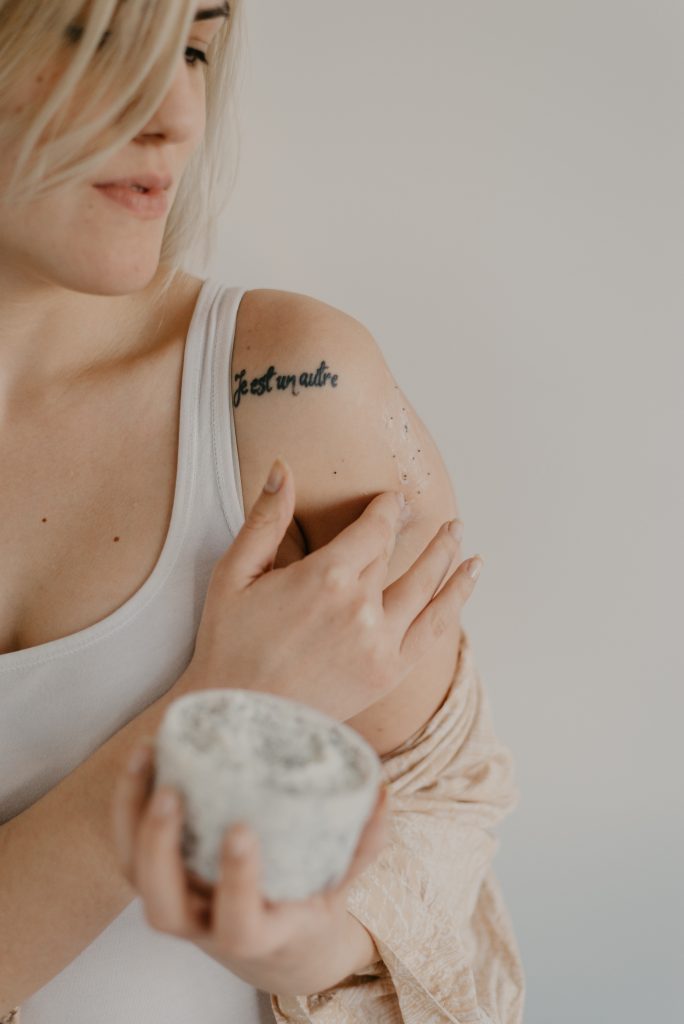
Keeping a Fresh Tattoo Clean
Keeping a fresh tattoo clean is as crucial as inking one. Failing to execute it properly can destroy even the most captivating art. Keep your tattoo clean by gently washing it to prevent infection. Wear baggy clothes to avoid rubbing and contamination.
Moisturize the skin with mild, scent-free lotions. Avoid scratching the area. Use a scent-free hypoallergenic soap to clean it. If you live in a place with no access to potable water, you can use distilled water. Another option is to use boiled tap water. Make sure to let it cool down first before use.
Aftercare
Listen to the advice of your tattoo artist. He will give you instructions on how to take care of the tattoo, so do your best to follow their instructions. Also, they have different methods of bandaging. Regardless of the method, you shuld follow their instructions to ensure the proper healing of your tattoo.
You may want to write down the instructions that they give you so you will not forget it.
Do not forget to use an SPF 50 (or higher) sunscreen to shield the tattoo. While it is true that tattoos eventually fades as we age; however, you can still preserve and maintain it.
Best Tattoo Aftercare Products
The use of specially formulated products for tattoo aftercare is essential if you want to keep the tattoo in good condition and also prevent any kind of skin issues that may occur after the artist has completed his masterpiece.
Several tattoo aftercare products are known for their quality and efficiency:
Hustle Butter Deluxe Tattoo Butter
An excellent and highly recommended aftercare product for tattoos, the Hustle Butter Deluxe Tattoo Butter provides a calming sensation over the affected area while concurrently stimulating immediate recovery and rehydration. It also has cooling properties that will provide relief from itchiness during the process of healing.
The lotion will also help limit scabbing which is why a lot of artists recommend regular application of this product. It has all-natural components that stimulate healthy skin and hasten the process of healing.
The Hustle Butter Deluxe Tattoo Butter is one of the most credible products for tattoo aftercare. It is good for any type of skin because of its mild components. Since it only utilizes all-natural ingredients, the possibility of getting negative side effects is very minimal.
Organic Tattoo Aftercare Balm
One of the ideal things about the Organic Tattoo Aftercare Balm is that it is 100 percent natural. It simply means that users do not have to be anxious about stringent chemicals that can trigger irritation, particularly if one has sensitive skin.
The balm’s main ingredients include carnauba wax, jojoba wax, extra virgin olive oil, beeswax, and coconut oil, which help protect the tattoo. Also, to remove customers’ apprehensions about the product, the manufacturer is giving a one-month money-back guarantee if you are not satisfied with it.
Redemption Tattoo Lubricant
Redemption Tattoo Lubricant is another tattoo aftercare product that is one of the best in the market. If you are an environment-friendly person, then you are likely to appreciate this product since it is composed of 100 percent natural ingredients and it has never been tested on animals.
Its natural ingredients include calendula oil, coconut oil, beeswax, and rosemary extract that helps strengthen the process of healing. This product also protects the tattoo from drying and prevents bacterial infections.
This product serves as a substitute to petroleum jelly (which tattoo artists use a lot) and helps calm the skin. The healing process becomes tolerable since it diminishes pain and soreness and keeps the skin moisturized.
Tattoo Goo Original Aftercare Salve
Tattoo Goo is a well-known aftercare lotion. Many tattoo parlors will likely recommend this to their customers. The ingredients contained in this product are often present in small amounts, which significantly lowers the risk of side effects.
Its main ingredients include wheat germ, olive oil, cocoa butter, and beeswax. It does not contain lanolin, mineral oil, and petroleum so you do not have to be anxious about side effects when applied to the skin.
Remember that this product is a balm; hence, application to the skin may take more time compared to lotions. This product also has calming properties and can reduce itchiness during healing. Tattoo Goo Original Aftercare Salve is a must-have for individuals who have sensitive skin.
Another good thing about this product is that it is formulated not to attach to fabric and clothes. It immediately dries and is penetrated by the skin after several minutes. It has an herbal scent because it contains rosemary and lavender oil. To some people, this is not a problem; however, some people prefer scent-less aftercare ointment.
Using this balm will brighten your tattoo; this effect is normal and will vanish after some time.
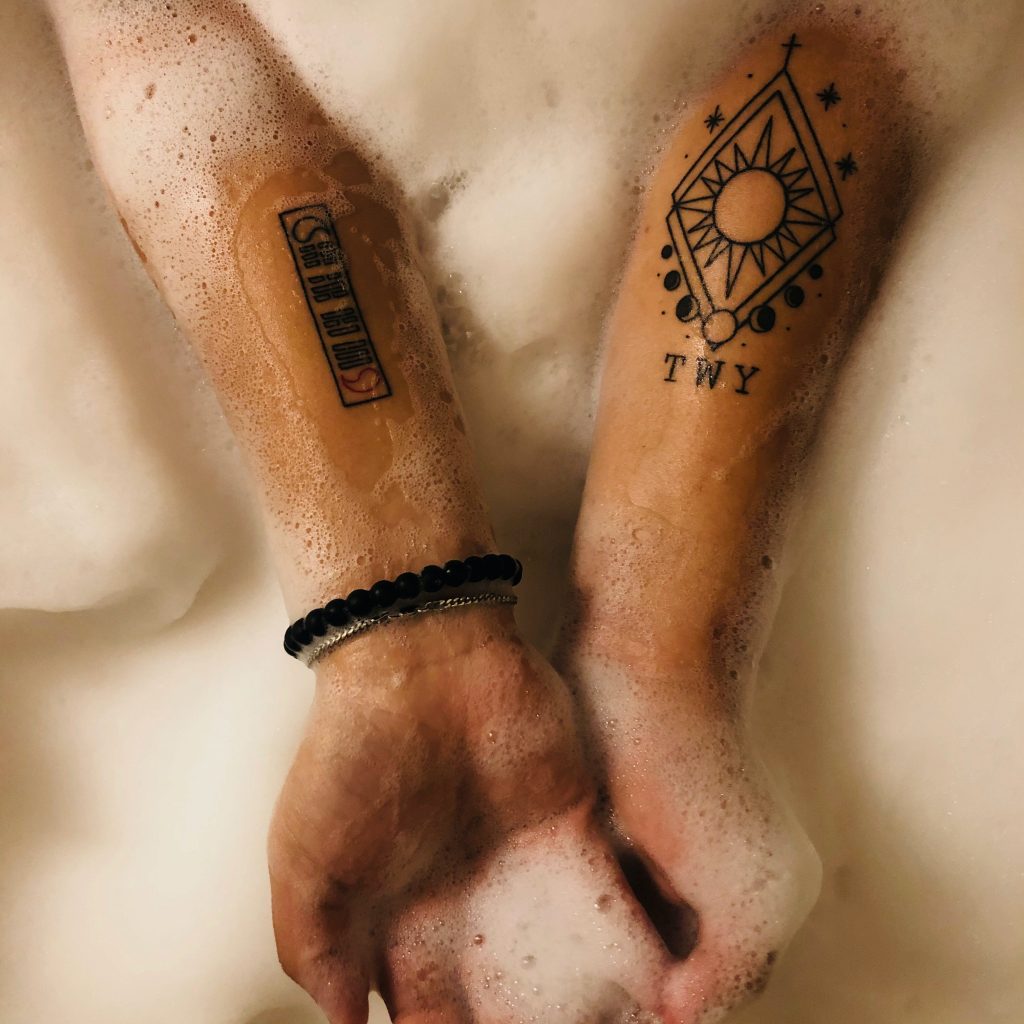
Tattoo Goo Deep Cleansing Soap
Tattoo Goo Deep Cleaning soap is antimicrobial, but is gentle to use on the skin. Its unique cleansing agents cleans at the root level by getting rid of dead skin cells and dirt and inhibiting bacterial growth and infection. The new, healthy skin layers thus become more defined – an essential step in healing.
When selecting a soap, you should get the one that is not rough to the skin. Rough soaps can dry out the skin; dry skin tend to conceal more viruses and bacteria. Tattoo Goo Deep Cleansing Soap is different from other soaps because it has a marginally acidic PH and has an important ingredient that helps safeguard the skin (while offering more killing power against microbes).
Even at the first use, you will immediately feel that it enhances healing and moisturization of the skin and reduces pain. The natural scent will not cause irritation.
Its ingredients are mild on the skin and works efficiently and quickly on the tattooed area. Furthermore, it does not cause pain or any side effect on the skin. Its formulation will not cause dryness and irritation because of its pH stability and mild ingredients.
Conclusion
Your tattoo aftercare journey begins after you leave the tattoo shop. You must follow the instructions of the tattoo artists, particularly on how to take care of your new tattoo. Be aware of the do’s and don’ts of tattoo aftercare, and remember that the condition/status of your tattoo will depend on how you take care of it. If you diligently maintained and took good care of your tattoo, you can expect it to still be captivating even after several years.
However, if you are worried about the healing process, you can consult these two people – your physician and tattoo artist. They will give you useful tips and advice on how to manage your tattoo aftercare. Just make sure not to miss any crucial advice. Having some of the best tattoo aftercare products and following expert advice will surely keep your tattoo protected during the healing process.
Every tattoo heals a bit differently depending on the person and the tattoo’s location on the body. The process of healing has four stages and typically includes bleeding, stinging, peeling, and continuous aftercare. It is necessary to be persistent in following aftercare routines to prevent the tattoo from getting infected.




